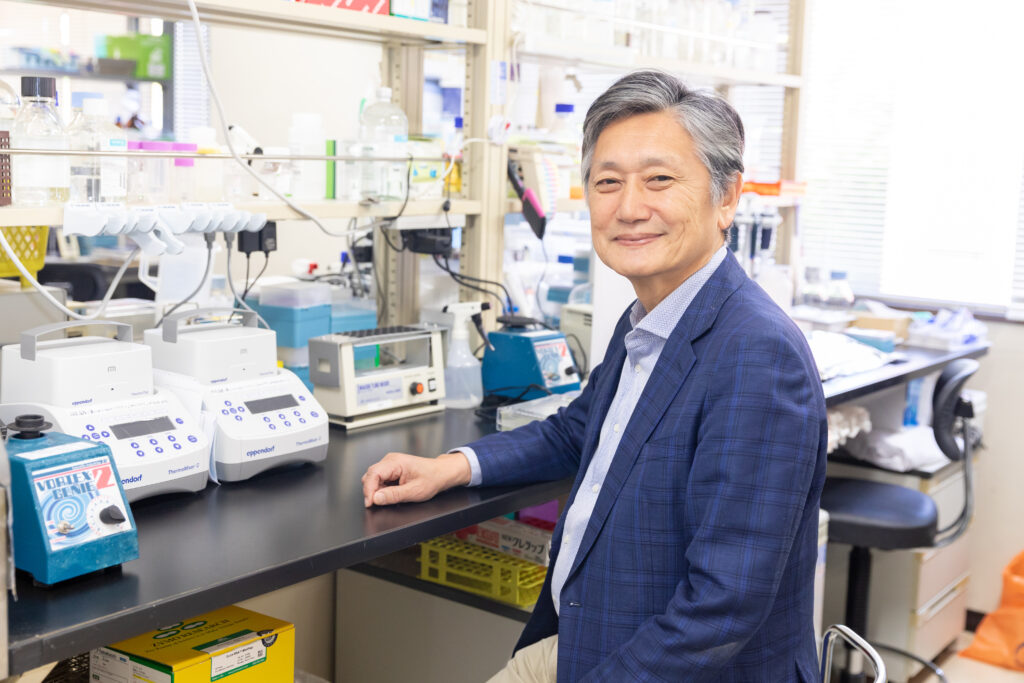Education
- Faculty of Medicine, Mie University (M.D.)
- Graduate School of Medicine, Mie University (Ph.D.)
Professional Experiences
- 1991: Research Associate, Graduate School of Medicine, Nagoya University
- 1991: Postdoctoral Fellow, Salk Institute, San Diego, USA
- 1993: Lecturer, Graduate School of Medicine, Nagoya University
- 1995: Assistant Professor, Graduate School of Medicine, Nagoya University
- 1997: Professor, Medical Research Institute, Tokyo Medical and Dental University
- 2003: Professor, School of Biomedical Sciences, Tokyo Medical and Dental University
- 2010: Professor, Department of Anatomy and Developmental Biology, Graduate School of Medicine, Kyoto University
Research Focus
The main objective of my research is to develop novel therapeutic methods manipulating transcriptome with small chemicals to cure genetic diseases. To realize this objective, my laboratory has developed original cell-based assay technologies. Initially, I succeeded to visualize the activation steps of a transcription factor CREB in living cells by producing a phospho-specific antibody of CREB (Hagiwara et al. Mol Cell Biol. 1993). We further developed a fluorescence resonance energy transfer (FRET) method for visualizing phosphorylation of proteins in living cells using a novel fluorescent indicator composed of two green fluorescent protein (GFP) variants joined by the kinase-inducible domain (KID) of CREB (Nagai et al. Nat Biotechnol. 2000). Then, we were successful in visualizing tissue-specific and developmental-stage-specific alternative splicing patterns in living nematode worms, and identified the regulatory factors by genomic mapping of the mutants (Kuroyanagi et al. Nat Methods 2006). To share the newly developed techniques with other researchers of this field, detailed protocols were published (Kuroyanagi et al. Nat Protoc. 2010). I further developed the splicing reporter technology, established a dual-color splicing reporter screening system called SPREADD (splicing reporter assay for disease genes with dual-color), applied this to aberrant splicing of IKBKAP exon 20 found in FD patients due to the intronic mutation (IVS20+6T>C), and identified a compound RECTAS that efficiently corrects the mis-splicing of IKBKAP (Yoshida et al. PNAS. 2015).
To realize the new therapeutics and rescue patients who suffer incurable diseases, I started my own venture company Kinopharma Co Ltd. in 2005 as an entrepreneur. In cooperation with Kinopharma, I have developed an anti-virus drug FIT039 targeting host factors required for virus proliferation. FIT039 specifically inhibits CDK9 and suppresses viral transcription of a broad spectrum of DNA viruses including HCMV, HAdV, HBV and HPV without significant adverse effect on mammalian cells (Yamamoto et al. J Clin Invest. 2014, Ajiro et al. Clin Cancer Res. 2018). Thus, the phase1/2a clinical trial of FIT039 is under way in Kyoto University Hospital for the patients of skin warts caused by Human papilloma virus. The clinical trial for cervical cancer of uterus with FIT039 will also start soon.
Membership in Academic Societies
- Japanese Society for Chemical Biology
- Japanese Association of Anatomists
- Japanese Pharmacological Society
- RNA Society of Japan
- Japanese Society for Virology
- Japanese Cancer Association
- Japanese Muscle Society
- Japan Neuroscience Society
- Japanese Biochemical Society
- Molecular Biology Society of Japan
- International Chemical Biology Society
Selected Publications
Matsushima S, Ajiro M, Iida K, Chamoto K, Honjo T, Hagiwara M. Chemical induction of splice-neoantigens attenuates tumor growth in a preclinical model of colorectal cancer. Sci Transl Med. 2022 Nov 30; 14(673):eabn6056. DOI: 10.1126/scitranslmed.abn6056.
Ajiro M, Awaya T, Kim YJ, Iida K, Denawa M, Tanaka N, Kurosawa R, Matsushima S, Shibata S, Sakamoto T, Studer L, Krainer AR, Hagiwara M. (2021) Therapeutic manipulation of IKBKAP mis-splicing with a small molecule to cure familial dysautonomia. Nat Commun. 12(1):4507. DOI: 10.1038/s41467-021-24705-5.
Maeda S, Shiimura Y, Asada H, Hirata K, Luo F, Nagano E, Tanaka N, Toyomoto M, Inoue A, Aoki J, Iwata S, Hagiwara M. (2021) Endogenous agonist-bound S1PR3 structure reveals determinants of G protein-subtype bias. Sci Adv. 7(24):eabf5325. DOI: 10.1126/sciadv.abf5325.
Toyomoto M, Inoue A, Iida K, Denawa M, Kii I, Ngako Kadji FM, Kishi T, Im D, Shimamura T, Onogi H, Yoshida S, Iawata S, Aoki J, Hosoya T, Hagiwara M. (2021) S1PR3-G12-biased agonist ALESIA targets cancer metabolism and promotes glucose starvation. Cell Chem Biol. 28(8):1132-1144.e9. DOI: 10.1016/j.chembiol.2021.01.004.
Nakano-Kobayashi A, Fukumoto A, Morizane A, Nguyen DT, Le TM, Hashida K, Hosoya T, Takahashi R, Takahashi J, Hori O, Hagiwara M. (2020) Therapeutics potentiating microglial p21-Nrf2 axis can rescue neurodegeneration caused by neuroinflammation. Sci Adv. 6(46):eabc1428. DOI: 10.1126/sciadv.abc1428.
Shibata S, Ajiro M, Hagiwara M. (2020) Mechanism-Based Personalized Medicine for Cystic Fibrosis by Suppressing Pseudo Exon Inclusion. Cell Chem Biol. 27(12):1472-1482.e6. DOI: 10.1016/j.chembiol.2020.08.013.

